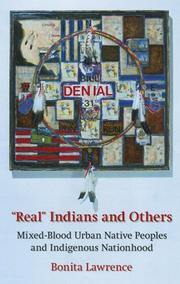| Listing 1 - 10 of 25 | << page >> |
Sort by
|

ISBN: 9780897896979 Year: 2004 Publisher: Westport (Conn.) Praeger
Abstract | Keywords | Export | Availability | Bookmark
 Loading...
Loading...Choose an application
- Reference Manager
- EndNote
- RefWorks (Direct export to RefWorks)
Book
Year: 1996 Publisher: Brussel Dienst Uitgaven VUB
Abstract | Keywords | Export | Availability | Bookmark
 Loading...
Loading...Choose an application
- Reference Manager
- EndNote
- RefWorks (Direct export to RefWorks)
Book
ISBN: 9781781688311 Year: 2014 Publisher: London Verso
Abstract | Keywords | Export | Availability | Bookmark
 Loading...
Loading...Choose an application
- Reference Manager
- EndNote
- RefWorks (Direct export to RefWorks)
INEQUALITY -- 301.187 --- ANTI-CASTE PLEA -- 301.187 --- CASTE SYSTEM -- 301.187
Multi
ISSN: 12907332 21052417 ISBN: 9782746714083 2746714086 2746758970 Year: 2010 Volume: 261 Publisher: Paris Autrement
Abstract | Keywords | Export | Availability | Bookmark
 Loading...
Loading...Choose an application
- Reference Manager
- EndNote
- RefWorks (Direct export to RefWorks)
Une brève histoire de la jupe depuis les années 1960 par une historienne féministe. Du tailleur à la jupe punk, de la minijupe au kilt, séduire, provoquer ou se cacher, Christine Bard réfléchit à cet attribut controversé de la féminité, et à la revendication d'une nouvelle liberté pour les hommes. Alors que la jupe a longtemps été subie et vécue comme l'attribut d'une féminité imposée (puisque le pantalon était interdit aux femmes), elle a été reconquise, par les femmes, mais aussi par les hommes, homos ou hétérosexuels. Nouvel étendard de féminité pour les uns, instrument de libération pour d'autres. Les positions de Ni Putes ni soumises, l'initiative du Printemps de la jupe et du respect, le film, La Jupe, avec Isabelle Adjani, tous ces éléments révèlent des ambivalences radicales : la jupe est-elle forcément le signe de la soumission à l'ordre masculin ? Peut-elle aussi être un attribut de féminité reconquise ? Pour résister à la stigmatisation et au sexisme, pourquoi certaines filles choisissent-elles la jupe, quand d'autres préfèrent le pantalon, et d'autres encore le voile ? Et que dire de la jupe pour hommes, telle que la propose par exemple Jean-Paul Gautier ? Provocation pure et simple, ou désir d'égalité entre les sexes ? A l'évidence, la jupe et les questions vestimentaires sont au cœur des débats sur les identités de genre, pour une nouvelle génération : les enfants et petits-enfants de 68, garçons et filles, hétéro, homo ou transgenres. Ces mutations contemporaines complexes sont analysées dans un esprit alerte, drôle et rigoureux à la fois.
Clothing and dress --- Gender identity. --- Vêtements --- Identité sexuelle --- Social aspects --- Psychological aspects --- Aspect social --- Aspect psychologique --- KLEDING -- 301.187 --- JURKEN EN ROKKEN -- 301.187 --- VROUWEN -- 301.187 --- Geschlechterbeziehung. --- Rock. --- Sozialgeschichte. --- Vêtements --- Identité sexuelle --- Fashion --- Social aspects.
Book
ISBN: 9781478016106 9781478018742 Year: 2022 Publisher: Durham, N.C. Duke University Press
Abstract | Keywords | Export | Availability | Bookmark
 Loading...
Loading...Choose an application
- Reference Manager
- EndNote
- RefWorks (Direct export to RefWorks)
Book
ISBN: 9781982153786 9781982153793 Year: 2023 Publisher: New York : One Signal Publishers/Atria,
Abstract | Keywords | Export | Availability | Bookmark
 Loading...
Loading...Choose an application
- Reference Manager
- EndNote
- RefWorks (Direct export to RefWorks)
"Acclaimed Harvard sociologist makes the case for reexamining what we value to prioritize recognition--the quest for respect--in an age that has been defined by growing inequality and the obsolescence of the American dream. In this capstone work, Michèle Lamont unpacks the power of recognition--rendering others as visible and valued--by drawing on nearly forty years of research and new interviews with young adults, and with cultural icons and change agents who intentionally practice recognition--from Nikole Hannah Jones and Cornel West to Michael Schur and Roxane Gay. She shows how new narratives are essential for everyone to feel respect and assert their dignity."--
LGBTQIA+ COMMUNITY -- 301.187 --- Self-evaluation --- Self-evaluation. --- Social comparison --- Social comparison. --- Economic aspects.
Book
ISBN: 9782021004076 2021004074 Year: 2010 Publisher: Paris Seuil
Abstract | Keywords | Export | Availability | Bookmark
 Loading...
Loading...Choose an application
- Reference Manager
- EndNote
- RefWorks (Direct export to RefWorks)
Pants --- Gender identity --- Pantalons --- Identité sexuelle --- History --- Social aspects --- Histoire --- Aspect social --- MANNELIJKHEID -- 301.153 --- MACHT -- 301.153 --- LANGE BROEKEN -- 301.187 --- PANTALONS -- 301.187 --- MANNELIJKHEID -- 301.187 --- MACHT -- 301.187 --- PANTALONS -- 301.153 --- History. --- Social aspects. --- Identité sexuelle --- Pantaloons --- Slacks --- Trousers --- Clothing and dress --- Sex identity (Gender identity) --- Sexual identity (Gender identity) --- Identity (Psychology) --- Sex (Psychology) --- Queer theory --- Pants - History --- Pants - Social aspects --- Gender identity - History --- Pantalons - Histoire --- Pantalons - Aspect social --- Identité sexuelle - Histoire --- Gender dysphoria

ISBN: 0195125851 Year: 2000 Publisher: New York Oxford University Press
Abstract | Keywords | Export | Availability | Bookmark
 Loading...
Loading...Choose an application
- Reference Manager
- EndNote
- RefWorks (Direct export to RefWorks)
Door deze reader wil de samensteller, Michael Kimmel, bewijzen dat er niet echt zo veel verschillen zijn tussen mannen en vrouwen als meestal wordt beweerd. Er zijn veel grotere verschillen tussen mannen of vrouwen onderling, met name verschillen in etnische afkomst, ras, klasse, seksualiteit of ouderdom. Mannen en vrouwen komen niet elk van een andere planeet, hoewel de geschiedenis en de hedendaagse samenleving veelal het vermoeden doen rijzen dat dit wel het geval is.
SEX DISCRIMINATION -- 301.187 --- SEX ROLE -- 301.187 --- SEX DIFFERENCES -- 301.187 --- Sociology of minorities --- Sociology of the family. Sociology of sexuality --- Ethnology. Cultural anthropology --- Sociology of work --- Human physiology --- Teaching --- Developmental psychology --- Primary groups --- Social problems --- Psychology --- Gender --- Violence --- Family --- Identity --- Gender roles --- Love --- Relationship man and women --- Labour --- Education --- Relationships --- Sexual intimidation --- Friendships --- Biology --- Book --- Sex differences --- Edited volume --- Discrimination --- Anthropology
Book
ISBN: 9780521862134 9780521680486 9780511551956 9780511508158 0511508158 0521680484 0521862132 9780511504266 0511504268 9780511506406 0511506406 0511551959 1107196663 9786612058288 1282058282 0511507496 0511508816 9781107196667 6612058285 9781282058286 9780511507496 9780511508813 Year: 2008 Publisher: Cambridge Cambridge University Press
Abstract | Keywords | Export | Availability | Bookmark
 Loading...
Loading...Choose an application
- Reference Manager
- EndNote
- RefWorks (Direct export to RefWorks)
In the late 1960s identity politics emerged on the political landscape and challenged prevailing ideas about social justice. These politics brought forth a new attention to social identity, an attention that continues to divide people today. While previous studies have focused on the political movements of this period, they have neglected the conceptual prehistory of this political turn. Linda Nicholson's engaging book situates this critical moment in its historical framework, analyzing the concepts and traditions of racial and gender identity that can be traced back to late eighteenth-century Europe and America. She examines how changing ideas about social identity over the last several centuries both helped and hindered successive social movements, and explores the consequences of this historical legacy for the women's and black movements of the 1960s. This insightful study will be of particular interest to students and scholars of political history, identity politics and US history.
Social change --- Sociology of cultural policy --- United States --- USA -- 301.187 --- WOMEN -- 301.187 --- AFRICAN AMERICANS -- 301.187 --- CIVIL RIGHTS MOVEMENTS -- 301.187 --- RACE -- 301.187 --- GENDER -- 301.187 --- GROUP IDENTITY -- 930.3 --- SOCIAL MOVEMENTS -- 930.3 --- USA -- 930.3 --- AFRICAN AMERICANS -- 930.3 --- CIVIL RIGHTS MOVEMENTS -- 930.3 --- RACE -- 930.3 --- GENDER -- 930.3 --- SOCIAL MOVEMENTS -- 301.187 --- WOMEN -- 930.3 --- Group identity --- Women --- African Americans --- Women's rights --- Civil rights movements --- Civil liberation movements --- Liberation movements (Civil rights) --- Protest movements (Civil rights) --- Human rights movements --- Afro-Americans --- Black Americans --- Colored people (United States) --- Negroes --- Africans --- Ethnology --- Blacks --- Human females --- Wimmin --- Woman --- Womon --- Womyn --- Females --- Human beings --- Femininity --- Collective identity --- Community identity --- Cultural identity --- Social identity --- Identity (Psychology) --- Social psychology --- Collective memory --- History. --- Identity --- Race identity --- Identity politics --- Politics of identity --- Political participation --- Political aspects --- Black people --- Social Sciences --- Sociology --- History --- United States of America --- Race --- Gender --- Book

ISBN: 1280423684 9786610423682 0803204191 9780803204195 9781280423680 6610423687 0803229526 9780803229525 0803280378 9780803280373 Year: 2004 Publisher: Lincoln : University of Nebraska Press,
Abstract | Keywords | Export | Availability | Bookmark
 Loading...
Loading...Choose an application
- Reference Manager
- EndNote
- RefWorks (Direct export to RefWorks)
Indians of North America --- American aborigines --- American Indians --- First Nations (North America) --- Indians of the United States --- Indigenous peoples --- Native Americans --- North American Indians --- Tribal citizenship --- Mixed descent --- Urban residence --- Culture --- Ethnology --- Mixed bloods --- Canada --- Politics and government. --- Social policy. --- Race relations. --- Indiens d'Amérique --- Métis --- Habitat urbain --- Nationalité ethnique --- Relations raciales --- Politique sociale --- Politique et gouvernement --- RACISM -- 301.187 --- INDIANS OF NORTH AMERICA -- 301.187 --- CANADA -- 301.187
| Listing 1 - 10 of 25 | << page >> |
Sort by
|

 Search
Search Feedback
Feedback About UniCat
About UniCat  Help
Help News
News